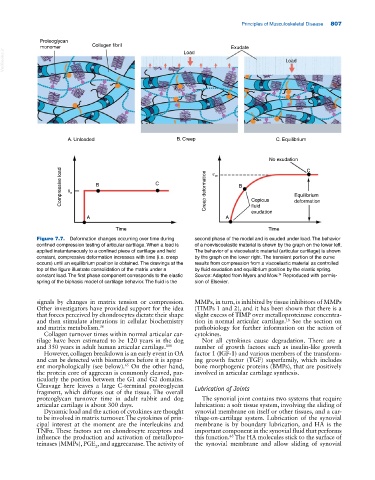Page 841 - Adams and Stashak's Lameness in Horses, 7th Edition
P. 841
Principles of Musculoskeletal Disease 807
Proteoglycan
monomer Collagen fibril Load Exudate
VetBooks.ir Load
A. Unloaded B. Creep C. Equilibrium
No exudation C
Compressive load B C Creep deformation B Copious Equilibrium
deformation
exudation
A A fluid
Time Time
Figure 7.7. Deformation changes occurring over time during second phase of the model and is exuded under load. The behavior
confined compression testing of articular cartilage. When a load is of a nonviscoelastic material is shown by the graph on the lower left.
applied instantaneously to a confined piece of cartilage and held The behavior of a viscoelastic material (articular cartilage) is shown
constant, compressive deformation increases with time (i.e. creep by the graph on the lower right. The transient portion of the curve
occurs) until an equilibrium position is obtained. The drawings at the results from compression from a viscoelastic material as controlled
top of the figure illustrate consolidation of the matrix under a by fluid exudation and equilibrium position by the elastic spring.
constant load. The first phase component corresponds to the elastic Source: Adapted from Myers and Mow. Reproduced with permis-
74
spring of the biphasic model of cartilage behavior. The fluid is the sion of Elsevier.
signals by changes in matrix tension or compression. MMPs, in turn, is inhibited by tissue inhibitors of MMPs
Other investigators have provided support for the idea (TIMPs 1 and 2), and it has been shown that there is a
that forces perceived by chondrocytes dictate their shape slight excess of TIMP over metalloproteinase concentra
and then stimulate alterations in cellular biochemistry tion in normal articular cartilage. See the section on
18
and matrix metabolism. 36 pathobiology for further information on the action of
Collagen turnover times within normal articular car cytokines.
tilage have been estimated to be 120 years in the dog Not all cytokines cause degradation. There are a
and 350 years in adult human articular cartilage. 108 number of growth factors such as insulin‐like growth
However, collagen breakdown is an early event in OA factor 1 (IGF‐1) and various members of the transform
and can be detected with biomarkers before it is appar ing growth factor (TGF) superfamily, which includes
ent morphologically (see below). On the other hand, bone morphogenic proteins (BMPs), that are positively
65
the protein core of aggrecan is commonly cleaved, par involved in articular cartilage synthesis.
ticularly the portion between the G1 and G2 domains.
Cleavage here leaves a large C‐terminal proteoglycan Lubrication of Joints
fragment, which diffuses out of the tissue. The overall
proteoglycan turnover time in adult rabbit and dog The synovial joint contains two systems that require
articular cartilage is about 300 days. lubrication: a soft tissue system, involving the sliding of
Dynamic load and the action of cytokines are thought synovial membrane on itself or other tissues, and a car
to be involved in matrix turnover. The cytokines of prin tilage‐on‐cartilage system. Lubrication of the synovial
cipal interest at the moment are the interleukins and membrane is by boundary lubrication, and HA is the
TNFα. These factors act on chondrocyte receptors and important component in the synovial fluid that performs
influence the production and activation of metallopro this function. The HA molecules stick to the surface of
63
teinases (MMPs), PGE , and aggrecanase. The activity of the synovial membrane and allow sliding of synovial
2

